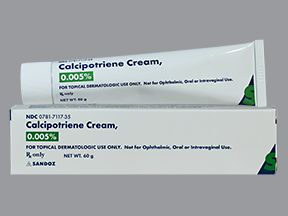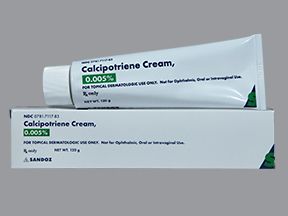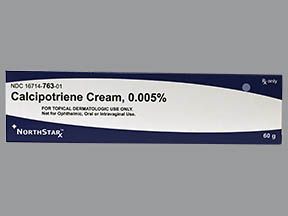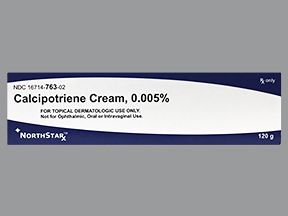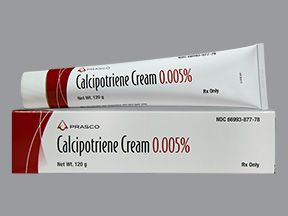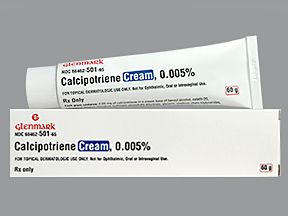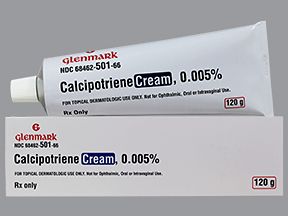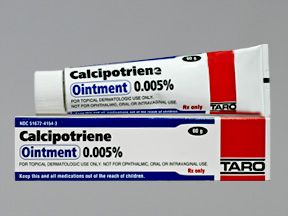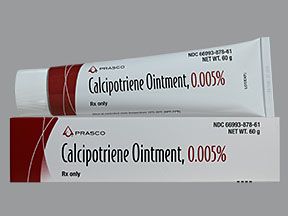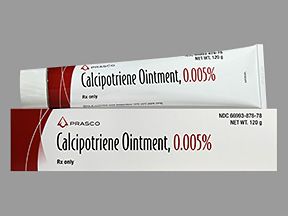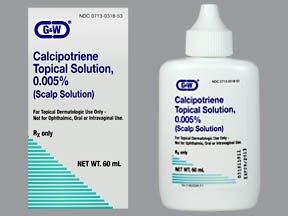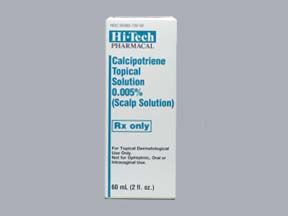Calcipotriene is a generic prescription medication. It’s approved by the Food and Drug Administration (FDA) to treat psoriasis in adults.
Psoriasis is an autoimmune disease, which means your immune system mistakenly attacks healthy cells and tissues in your body. The most common type of psoriasis is plaque psoriasis, which leads to plaques (patches) on your skin. These plaques are raised, may be discolored (typically reddish to silver in color), and may itch.
Drug details
Calcipotriene belongs to a drug class called synthetic vitamin D derivatives. (A drug class is a group of medications that work in the same way.)
Calcipotriene is a topical drug, which means you apply it to your skin. Topical calcipotriene is available in three dosage forms:
- topical cream
- topical ointment
- topical solution
Topical calcipotriene solution is only approved for treating psoriasis affecting your scalp. The topical cream and topical ointment are used to treat plaque psoriasis on any part of your body, such as your arms or legs.
For more information on how each form of the drug is used, see the “How to use topical calcipotriene” section below.
Brand-name versions
The calcipotriene cream is available as the brand-name product Dovonex. There’s no brand-name version of the calcipotriene ointment or solution.
Note: The aerosol foam form of topical calcipotriene is only available as the brand-name product Sorilux. It’s not available as a generic. For information on this version, talk with your doctor or pharmacist.
Effectiveness
For information about the effectiveness of topical calcipotriene, see the “Topical calcipotriene uses” section below.
Topical calcipotriene is a generic drug. A generic drug is an exact copy of the active drug in a brand-name medication. Dovonex is the brand-name medication that topical calcipotriene cream is based on. A generic is considered to be as safe and effective as the original drug. Generics tend to cost less than brand-name drugs.
If you’re interested in using Dovonex instead of topical calcipotriene, talk with your doctor. They can tell you if Dovonex comes in strengths that can be used for your condition. If you have insurance, you’ll also need to check whether your plan will cover Dovonex.
To learn more about how generics compare with brand-name drugs, see this article.
Topical calcipotriene may be used alone or with other drugs.
Calcipotriene is also available as a combination product that contains other drugs.
Calcipotriene with betamethasone dipropionate
Calcipotriene is available with betamethasone dipropionate as the following combination products:
- topical cream, as the brand-name drug Wynzora
- topical foam, in the brand-name drug Enstilar
- topical ointment, as a generic medication and the brand-name drug Taclonex
- topical suspension, as a generic medication and the brand-name drug Taclonex
Each of these combination drugs is used to treat psoriasis. If you have questions about whether one of these products is right for you, talk with your doctor or pharmacist.
Calcipotriene with fluorouracil (Efudex)
Topical calcipotriene may also be used with topical fluorouracil (Efudex) for treating actinic keratoses, which are precancerous growths on the skin. This combination of drugs may also reduce the risk of these growths developing into skin cancer.
It’s important to note that this is an off-label use of topical calcipotriene. (Off-label drug use means using a drug for a purpose other than what it’s been approved for by the FDA.) If you have questions about using calcipotriene with fluorouracil, talk with your doctor or pharmacist.
Topical calcipotriene can cause mild or serious side effects. The following lists contain some of the key side effects that may occur while taking topical calcipotriene. These lists do not include all possible side effects.
For more information about the possible side effects of topical calcipotriene, talk with your doctor or pharmacist. They can give you tips on how to deal with any side effects that may be concerning or bothersome.
Note: The Food and Drug Administration (FDA) tracks side effects of drugs it has approved. If you would like to notify the FDA about a side effect you’ve had with topical calcipotriene, you can do so through MedWatch.
Mild side effects
Mild side effects* of topical calcipotriene can include:
- skin irritation**
- dry skin
- inflammation of hair follicles
- itchy skin
- peeling skin
- skin rash
- temporary burning or stinging sensation after applying a dose
- skin discoloration
- skin atrophy (thinning of your skin)
Most of these side effects may go away within a few days or a couple of weeks. But if they become more severe or don’t go away, talk with your doctor or pharmacist.
* This is a partial list of mild side effects from topical calcipotriene. To learn about other mild side effects, talk with your doctor or pharmacist, or view the prescribing information for the calcipotriene cream, ointment, and solution.
** For more information about this side effect, see “Side effect details” below.
Serious side effects
Serious side effects from topical calcipotriene aren’t common, but they can occur. Call your doctor right away if you have serious side effects. Call 911 or your local emergency number if your symptoms feel life threatening or if you think you’re having a medical emergency.
Serious side effects and their symptoms can include:
- High calcium levels. Symptoms can include:
- Allergic reaction.*
- Worsening of psoriasis.*
* For more information about this side effect, see “Side effect details” below.
Side effect details
Here are some details on certain side effects this drug may cause.
Skin irritation
Skin irritation is a common side effect from using topical calcipotriene. This typically occurs at sites where you apply the drug.
To find out how often skin irritation occurred in clinical studies, see the prescribing information for the calcipotriene cream, ointment, and solution.
Studies of the drug didn’t specify symptoms of skin irritation in people who reported this side effect. But side effects that may be irritating to your skin can include:
- red or discolored skin
- itchy skin
- peeling skin
- skin atrophy (thinning of your skin)
If you think using topical calcipotriene is irritating your skin, let your doctor know right away. They’ll probably want to see you and examine your skin. If they believe calcipotriene is the cause of your irritation, they’ll likely have you stop using the drug and switch to a different treatment.
Itching
You may experience itching from using topical calcipotriene. This was a common side effect reported by people using the drug in clinical studies.
To find out how often itching occurred in studies, see the prescribing information for the calcipotriene cream, ointment, and solution.
If you experience itching during your calcipotriene treatment, talk with your doctor or pharmacist. They may be able to recommend ways to treat this side effect. Or they may recommend stopping your treatment with calcipotriene and switching to a different drug.
Worsening of psoriasis
Although topical calcipotriene is used to treat psoriasis, it’s also possible that it can make your psoriasis worse. This wasn’t common in studies of calcipotriene, but it can occur.
To learn how often this side effect occurred in studies, see the prescribing information for the calcipotriene cream, ointment, and solution.
It’s not known why calcipotriene causes worsening of psoriasis in some people. But this side effect should go away if you stop your calcipotriene treatment.
If you think your psoriasis is getting worse from using topical calcipotriene, talk with your doctor right away. They’ll probably want to see you and examine your skin. If your doctor thinks calcipotriene is the cause of your worsening psoriasis, they’ll likely have you stop using the drug and switch to a different treatment.
Allergic reactionAs with most drugs, some people can have an allergic reaction after using topical calcipotriene.
Symptoms of a mild allergic reaction can include:
- skin rash
- itchiness
A more severe allergic reaction is rare but possible. Symptoms of a severe allergic reaction can include:
- swelling under your skin, typically in your eyelids, lips, hands, or feet
- swelling of your tongue, mouth, or throat
- trouble breathing
Call your doctor right away if you have an allergic reaction to calcipotriene, as the reaction could become severe. Call 911 or your local emergency number if your symptoms feel life threatening or if you think you’re having a medical emergency.
Here are answers to some frequently asked questions about topical calcipotriene.
Is calcipotriene a steroid?
No, calcipotriene is not a steroid. Calcipotriene belongs to a class of medications called synthetic vitamin D derivatives.
Like calcipotriene, some corticosteroids (steroids) may be used to treat plaque psoriasis. For example, betamethasone propionate is a steroid prescribed to treat this condition. Sometimes, it’s used along with topical calcipotriene to treat plaque psoriasis.
If you have questions about steroids and plaque psoriasis, talk with your doctor or pharmacist. They can also answer any questions you may have about using a steroid with calcipotriene for treating psoriasis.
Can calcipotriene be used for eczema?
Calcipotriene is not approved to treat eczema. But the drug may be prescribed off-label to treat eczema. (Off-label drug use means using a drug for a purpose other than what it’s been approved for by the FDA.)
Calcipotriene may be used off-label to treat eczema because a
Does calcipotriene treat acne or scars?
Topical calcipotriene is not approved to treat acne or scars. However, the drug may be used off-label for these purposes.
If you have questions about using calcipotriene to treat acne or scars, talk with your doctor or pharmacist.
Is calcipotriene an alternative to calcipotriol?
No, calcipotriene is not an alternative to calcipotriol. Calcipotriol is another name for calcipotriene, and it’s used outside the United States.
Will my skin be more sensitive to sunlight while I’m using calcipotriene?
Yes, it’s possible that your skin will be more sensitive to sunlight during your calcipotriene treatment. But this only affects areas of your skin where you apply calcipotriene.
It’s important that areas of your skin where you apply calcipotriene are not exposed to natural or artificial (such as tanning beds) sunlight for too long. This is because calcipotriene may increase the likelihood of UV radiation causing skin cancer. You can protect your skin from UV light by wearing long clothing that covers your skin, using an umbrella when you have to be in the sun, and avoiding tanning beds.
If you have questions or concerns about sunlight exposure while using calcipotriene, talk with your doctor or pharmacist.
The topical calcipotriene dosage your doctor prescribes will depend on several factors. These include:
- the location and severity of your psoriasis plaques
- the form of topical calcipotriene you’re prescribed
The following information describes dosages that are commonly used or recommended. However, be sure to take the dosage your doctor prescribes for you. Your doctor will determine the best dosage to fit your needs.
Drug strength
Topical calcipotriene is available in three forms, each of which is only available in a strength of 0.005%:
- topical cream
- topical ointment
- topical solution
Dosage for psoriasis
The topical calcipotriene dosage for psoriasis depends on the form you’re prescribed.
- Topical cream: You’ll apply a thin layer twice per day to the skin where your psoriasis plaques are. Be sure to completely rub in your dose.
- Topical ointment: You’ll apply a thin layer once or twice per day to the skin where your psoriasis plaques are, as directed by your doctor. Be sure to completely rub in your dose.
- Topical solution: This form is only used for treating psoriasis on your scalp. You’ll apply this solution twice a day to affected areas on your scalp. Be sure to rub it in completely. Do not let the solution spread to your forehead or get in your eyes.
What if I miss a dose?
If you miss a dose of calcipotriene, try to apply it as soon as possible. But if it’s almost time to apply your next dose, just skip the missed dose and apply your next dose at its regular time. You should not apply more than one dose at a time to make up for the missed dose. Doing so could raise your risk for side effects.
To help make sure that you do not miss a dose, try using a medication reminder. This can include setting an alarm or timer on your phone or downloading a reminder app. A kitchen timer can work, too.
Will I need to use this drug long term?
Topical calcipotriene may be used as a long-term treatment. If you and your doctor determine that topical calcipotriene is safe and effective for you, you may take it long term.
The Food and Drug Administration (FDA) approves prescription drugs such as topical calcipotriene to treat certain conditions. Topical calcipotriene may also be used off-label for other conditions. Off-label drug use means using a drug for a purpose other than what it’s been approved for by the FDA.
Topical calcipotriene for psoriasis
Topical calcipotriene is used to treat psoriasis in adults. The calcipotriene solution is only approved for treating psoriasis affecting your scalp. The topical cream and topical ointment are used to treat plaque psoriasis on any part of your body, including your arms or legs.
Psoriasis is an autoimmune disease, which means your immune system mistakenly attacks healthy cells and tissues in your body. It causes your body to make skin cells too quickly, which pile up on the surface of your skin.
Plaque psoriasis is the most common type of psoriasis. In plaque psoriasis, plaques (patches) form on your skin. These plaques are raised and red, with white or silvery scales, and are usually itchy. They most commonly show up on your elbows, knees, lower back, and scalp. The size of the plaques can vary.
Effectiveness for psoriasis
Clinical studies have shown topical calcipotriene to be effective for treating plaque psoriasis and for psoriasis affecting the scalp. To see how the drug performed in these studies, view the prescribing information for the calcipotriene cream, ointment, and solution.
Guidelines from the American Academy of Dermatologists and National Psoriasis Foundation recommend topical calcipotriene as a treatment option for adults with psoriasis, including plaque psoriasis.
Topical calcipotriene and children
Topical calcipotriene is not approved for use in children. If you have questions about psoriasis treatments for children, talk with your child’s doctor.
Alcohol isn’t known to interact with topical calcipotriene. However,
If you drink alcohol, talk with your doctor about how much may be safe for you to drink with your condition and treatment plan.
Topical calcipotriene isn’t known to interact with other medications, herbs, supplements, or foods.
You should still talk with your doctor and pharmacist before using topical calcipotriene. Tell them about all prescription, over-the-counter, and other drugs you take. Also tell them about any vitamins, herbs, and supplements you use. Sharing this information can help you avoid potential interactions, for example, if new ones are discovered while you’re using topical calcipotriene.
If you have questions about drug interactions that may affect you, ask your doctor or pharmacist.
As with all medications, the cost of topical calcipotriene can vary. The actual price you’ll pay depends on your insurance plan, your location, and the pharmacy you use.
Keep in mind that you may be able to get a 90-day supply of topical calcipotriene. If approved by your insurance company, getting a 90-day supply of the drug could reduce your number of trips to the pharmacy and help lower the cost. If you’re interested in this option, check with your doctor or your insurance company.
Before approving coverage for topical calcipotriene, your insurance company may require you to get prior authorization. This means that your doctor and insurance company will need to communicate about your prescription before the insurance company will cover the drug. The insurance company will review the prior authorization request and decide if the drug will be covered.
If you’re not sure whether you’ll need to get prior authorization for topical calcipotriene, contact your insurance company.
Financial and insurance assistance
Financial assistance to help you pay for topical calcipotriene may be available.
Medicine Assistance Tool and NeedyMeds are two websites offering resources that may help decrease the price you pay for topical calcipotriene. They also offer tools to help you find low-cost healthcare, as well as educational resources. To learn more, visit their sites.
Mail-order pharmacies
Topical calcipotriene may be available through a mail-order pharmacy. Using this service may help lower the drug’s cost and allow you to get your medication without leaving home.
If recommended by your doctor, you may be able to receive a 90-day supply of topical calcipotriene, so there’s less concern about running out of the medication. If you’re interested in this option, check with your doctor and your insurance company. Some Medicare plans may help cover the cost of mail-order medications.
If you don’t have insurance, you can ask your doctor or pharmacist about online pharmacy options.
You should apply topical calcipotriene according to the instructions your doctor or other healthcare professional gives you.
With the calcipotriene cream or ointment, you’ll apply a thin layer to the skin where your psoriasis plaques (patches) are. Take care to avoid getting the cream or ointment in your eyes or on your face. Be sure to rub in your dose completely, and wash your hands thoroughly after applying it.
You’ll only use the topical solution if you’re treating psoriasis that affects your scalp. First, comb your hair to remove any flakes or scales. Then, apply the solution to affected areas on your scalp and rub in completely. Be sure to avoid letting the solution touch your forehead or get in your eyes. Wash your hands thoroughly after applying your dose.
When to use
If you’re using the topical cream or solution, you’ll apply a dose twice a day. Applying it in the morning and evening usually works best for most people.
If you’re using the topical ointment, you’ll apply a dose once or twice a day, as directed by your doctor. It doesn’t matter when you apply your dose if you’re taking it once a day, but it may be helpful to try and apply it at the same time each day. If you’re applying the ointment twice a day, applying it in the morning and evening at certain times can also help you get into a routine.
To help make sure you do not miss a dose, try using a medication reminder. This can include setting an alarm or timer on your phone or downloading a reminder app. A kitchen timer can work, too.
If you have questions about how to use topical calcipotriene, talk with your doctor or pharmacist. They can explain how to apply the drug.
Topical calcipotriene is used to treat psoriasis in adults. The calcipotriene solution is only approved for treating psoriasis affecting your scalp. The topical cream and topical ointment are used to treat plaque psoriasis on any part of your body, including your arms or legs.
About psoriasis
Psoriasis is an autoimmune disease, which means your immune system mistakenly attacks healthy cells and tissues in your body. It causes your body to make skin cells too quickly, which pile up on the surface of your skin.
Plaque psoriasis is the most common type of psoriasis. With this condition, plaques (patches) form on your skin. These plaques are raised, may be discolored (typically reddish to silver in color), and may itch. These plaques most commonly show up on your elbows, knees, lower back, and scalp. The size of these plaques can vary.
What topical calcipotriene does
It’s not known how calcipotriene works to treat psoriasis. But clinical studies have shown that the drug is effective for treating both plaque psoriasis and psoriasis affecting the scalp. To see how the drug performed in these studies, view the prescribing information for the calcipotriene cream, ointment, and solution.
How long does it take to work?
Topical calcipotriene begins working as soon as you apply a dose. In clinical studies, some people began seeing results after using the drug for 2 weeks. However, it may take up to 8 weeks before you see your psoriasis improve.
If you have questions about how topical calcipotriene works, or when you should see results, talk with your doctor or pharmacist.
It’s not known if topical calcipotriene is safe to take during pregnancy.
Animal studies showed some risk for bone abnormalities in offspring born to mothers given calcipotriene by mouth while pregnant. This doesn’t predict whether there’s risk with a topical form of the drug, though. And animal studies don’t always reflect what will happen in humans.
If you’re pregnant or planning to become pregnant, talk with your doctor before starting treatment with topical calcipotriene. They can review the risks and benefits of using this drug for your condition.
It’s not known if topical calcipotriene is safe to take during pregnancy. If you’re sexually active and you or your partner can become pregnant, talk with your doctor about your birth control needs while you’re using topical calcipotriene.
For more information about taking topical calcipotriene during pregnancy, see the “Topical calcipotriene and pregnancy” section above.
It’s not known whether it’s safe to use topical calcipotriene while breastfeeding. It’s not known whether the drug passes into breast milk, or whether it could cause side effects in a breastfed child.
If you’re breastfeeding or planning to breastfeed, talk with your doctor before using calcipotriene.
Before starting treatment with topical calcipotriene, talk with your doctor about your health history. This drug may not be right for you if you have certain medical conditions or other factors affecting your health. These include:
- High calcium levels or vitamin D levels. Using calcipotriene can cause you to have high calcium levels or vitamin D levels. If you already have high calcium or vitamin D levels, the drug may not be safe for you. Your doctor can help determine whether calcipotriene is right for you.
- Allergic reaction. If you’ve had an allergic reaction to calcipotriene or any of its ingredients, you should not take topical calcipotriene. Ask your doctor what other medications are better options for you.
- Pregnancy. It’s not known whether it’s safe to use calcipotriene during pregnancy. For more information, see the “Topical calcipotriene and pregnancy” section above.
- Breastfeeding. It’s not known whether it’s safe to use calcipotriene while breastfeeding. For more information, see the “Topical calcipotriene and breastfeeding” section above.
Note: For more information about the potential negative effects of calcipotriene, see the “Topical calcipotriene side effects” section above.
Do not use more Topical calcipotriene than your doctor recommends. For some drugs, doing so may lead to unwanted side effects or overdose.
It’s possible to use too much topical calcipotriene over time. This can lead to having high calcium levels, which can cause side effects such as:
- nausea and vomiting
- bone pain
- fatigue (lack of energy)
- confusion
- constipation
- depression
- memory problems
What to do in case you take too much topical calcipotriene
If you think you’ve used too much of this drug, call your doctor. You can also call the American Association of Poison Control Centers at 800-222-1222 or use their online tool. But if your symptoms are severe, call 911 or your local emergency number, or go to the nearest emergency room right away.
When you get topical calcipotriene from the pharmacy, the pharmacist will add an expiration date to the label on the packaging. This date is typically 1 year from the date they dispensed the medication.
The expiration date helps guarantee that the medication is effective during this time. The
Storage
How long a medication remains good can depend on many factors, including how and where you store the medication.
You should store topical calcipotriene at room temperature, from 68°F to 77°F* (20°C to 25°C) in a tightly sealed container away from light. For short periods, such as traveling, you can store calcipotriene between 59°F and 86°F (15°C to 30°C). Avoid storing this medication in areas where it could get damp or wet, such as bathrooms.
* Calcipotriene ointment may be stored long term at temperatures of 59°F to 77°F (15°C to 25°C).
Disposal
If you no longer need to take topical calcipotriene and have leftover medication, it’s important to dispose of it safely. This helps prevent others, including children and pets, from taking the drug by accident. It also helps keep the drug from harming the environment.
This article provides several useful tips on medication disposal. You can also ask your pharmacist for information about how to dispose of your medication.
Disclaimer: Medical News Today has made every effort to make certain that all information is factually correct, comprehensive, and up to date. However, this article should not be used as a substitute for the knowledge and expertise of a licensed healthcare professional. You should always consult your doctor or another healthcare professional before taking any medication. The drug information contained herein is subject to change and is not intended to cover all possible uses, directions, precautions, warnings, drug interactions, allergic reactions, or adverse effects. The absence of warnings or other information for a given drug does not indicate that the drug or drug combination is safe, effective, or appropriate for all patients or all specific uses.

